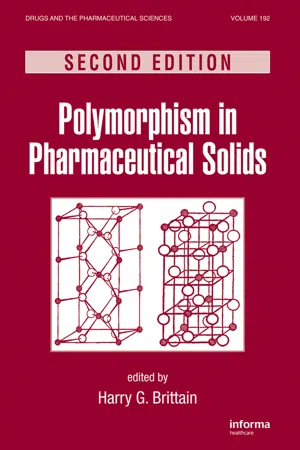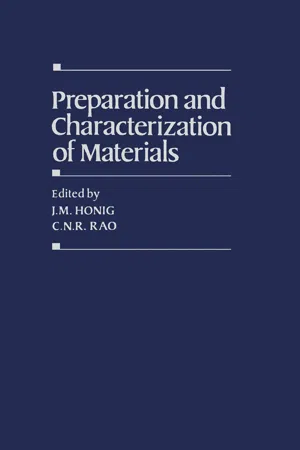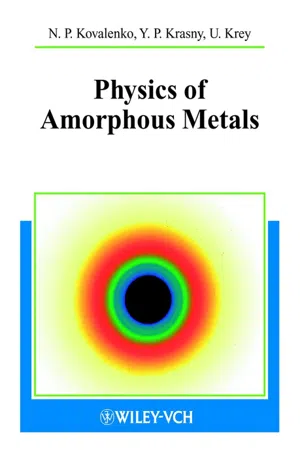Physics
Amorphous Solid
Amorphous solids are materials that lack a regular, crystalline structure. Instead, their atoms or molecules are arranged in a disordered fashion. This results in properties such as a lack of a distinct melting point and the ability to flow over time, distinguishing them from crystalline solids. Examples of amorphous solids include glass and certain plastics.
Written by Perlego with AI-assistance
Related key terms
1 of 5
8 Key excerpts on "Amorphous Solid"
- eBook - ePub
- Ruren Xu, Yan Xu(Authors)
- 2010(Publication Date)
- Elsevier(Publisher)
Chapter 20 Amorphous MaterialsZhuang-Qi Hu, Institute of Metal Research, Chinese Academy of Sciences, ChinaAmorphous materials are amongst one of the important types of nonequilibrium materials. Traditionally, the solid physics refers to crystal physics, usually in equilibrium state in which the atomic arrangement is of long-range periodicity. In recent years, the metastable materials at far from the equilibrium state have become one of the most active research fields. The reasons being: (i) many new preparation techniques are developed for producing various kinds of metastable materials; and (ii) due to rapid progress of high technology a lot of new materials having various exceptionally peculiar properties and functions are required. The deep theoretical understanding of the amorphization and nonequilibrium state guides and promotes the research and development of amorphous materials.This chapter briefly summarizes the structure, formation criteria, and preparation technology of amorphous materials.20.1 Amorphous Structure
Crystalline and amorphous materials are all real solid, possessing basic characteristics of solid materials. The main discrepancy is the difference in atomic-scale structure. In crystal, the atomic equilibrium locations are arranged in a long-range periodicity and on the contrary in the amorphous there is a lack of long-range periodicity and they have a disordered arrangement as shown in Fig. 20.1 . In this case the amorphous material can also be termed as metallic glass material.FIGURE 20.1 Schematic representation of atomic arrangements in crystal, amorphous and gas. (a) crystalline, (b) amorphous, and (c) gas.R. Zallen, The Physics of Amorphous Solids, Wiley-Interscience Publication, Copyright 1983 Wiley-VCH Verlag GmbH & Co. KGaA. Reproduced with permission.20.1.1 Morphology of Noncrystal
Figure 20.2 demonstrates the path from gaseous state to solid state. During cooling, the gaseous atoms transform to liquid atoms at boiling temperature T b , and the liquid volume continuously drops. The slope of V (T ) curve is the thermal expansion coefficient of the liquid. When the temperature is lowered to the melting point T f , the liquid transforms to solid state (except liquid helium). One of the characteristics of solid is the smaller slope of V (T ) curve. The transition of liquid to solid can be expressed by the abrupt volume contraction and discontinuity of V (T ) curve. If the cooling rate is rapid enough, the liquid state can be maintained right up to the glass transition temperature T g - eBook - PDF
- John Loveday(Author)
- 2012(Publication Date)
- Chapman and Hall/CRC(Publisher)
4 Amorphous materials Glasses and amorphous materials are non-crystalline and posses some degree of randomness, in the form of topological or spin disorder but it is not unique. Such a definition for example necessarily describe a non-crystalline state as many crystals are imperfect containing vacancies, substitution disorder etc. Topological disorder is the form of randomness in which there is no transla-tional periodicity and this provides us with a definition of an amorphous ma-terial [10, 11]. An amorphous material is synonymous with a non-crystalline material by this definition, in other words an amorphous material does not posses the long-range order that is characteristic of a crystal. The term glass is more restrictive. A glass is a solid amorphous phase that exhibits an abrupt change in thermodynamic properties (heat capacity or thermal conductivity) from crystal-like to liquid-like values with temperature. This definition distin-guishes glasses (or the vitreous state) from amorphous materials which can include liquids, glasses are restricted in definition to those materials that can be obtained in a reproducible state even after thermal recycling. The oldest and most well-established method of forming Amorphous Solids is to cool the liquid sufficiently quickly. Although materials produced in this way invariably show glassy behaviour the feature of this melt-quenching pro-cess is continuous hardening, in other words and increase in viscosity. A pre-requisite to formation of an amorphous material by this technique is that the cooling must be sufficiently fast to avoid nucleation. This depends on the speed at which the crystal-liquid interface moves and scales with viscosity. It is easy to identify liquids that might be expected to be good glass for-mers; liquids with high viscosity and which reflect competing timescales that result from the free energy difference between crystals and liquids. This is a - eBook - PDF
- Harry G. Brittain(Author)
- 2018(Publication Date)
- CRC Press(Publisher)
The importance of temperature to the macroscopic behavior and the underlying molecular level structure will be addressed in much greater depth throughout this chapter. The feature that distinguishes the amorphous “solid” from a crystalline solid is the absence of repeat three-dimensional order that persists over long length scales (i.e., many, many molecules). Amorphous Solids do show short-range order (2), and in many cases the short-range order is similar to that seen in a liquid. Essentially, this means that nearest neighbor interactions are maximized in the Amorphous Solid where possible, to obtain a local minimum in the free energy. The short-range order found in amorphous substances stems from packing of the molecules to form near-est neighbor interactions through van der Waals interactions, hydrogen bonding, or electrostatic interactions, and the local packing may or may not be similar to the short-range order found in the crystalline counterpart. The locally favored structure is not periodic over long distances. Thus, amorphous materials are isotropic over longer length scales, whereas most organic crystals display directionally dependent properties as a result of their three-dimensional order. Accompanying the more random arrangement of molecules in amorphous materials is a higher free volume compared to a crystalline solid. Free volume can be determined quantitatively by the difference in the total volume and the molecu-lar volume as defined using van der Waals radii. - eBook - PDF
- Richard Zallen(Author)
- 2008(Publication Date)
- Wiley-VCH(Publisher)
The structure (static for the glass, everchanging for the liquid) is of the type indicated in Fig. 1.66 for both materials, but the motion is as in Fig. 1 . 7 ~ for the solid container and as in Fig. 1.7b for its fluid contents. Amorphous Solids are bona fide solids, having all of the requisite elastic properties (shear stiffness, etc.). There is no need to belabor this point, many of the applications of these materials (look ahead to Table 1.2) rely explicitly on properties such as rigidity and strength. Note that neither the macroscopic (rigidity, etc.) nor the atomic (Fig. 1 . 7 ~ ) description of solidity makes any reference to the presence or absence of structural long-range order, indeed, solidity is not synonymous with crystallinity. It should not be necessary any longer to emphasize that solidity # crystallinity. Unfortunately, it is, in fact, necessary to do so. The reason for this necessity arises from the following circumstance: Amorphous Solids are rarely included in textbooks on solid-state physics. If one were tempted to define the subject of “solid-state physics” by the content of current textbooks with that title, one might erroneously conclude that solid-state physics is synonymous with crystal physics. So much is this the case, in fact, that it is standard procedure for a course on the physics of solids to begin with a discus- sion of crystal lattices and translational periodicity as ifperiOdiGity were a p r e y -uisitefor solidity. Since it blithely ignores an entire important class of solids, this attitude is completely wrong. This mistaken premise, the exclusive association of solidity with crys- tallinity, brings us to the third in the troika of topics listed in the title of this section. This topic has to do with the issue of the respectability of Amorphous Solids as proper inhabitants of the solid state. - J Honig(Author)
- 2012(Publication Date)
- Academic Press(Publisher)
VI. AMORPHOUS MATERIALS INCLUDING GLASSES This page intentionally left blank Amorphous SolidS: TYPES, CHARACTERISTICS AND CHALLENGES C. A. Angell 1 Department of Chemistry Purdue University West Lafayette, Indiana 47907 I. INTRODUCTION Amorphous Solids constitute a class of material in which the thermodynamic and mechanical properties of solid materials, and the lack of order usually associated with the liquid state, are combined. Amorphous Solids can be prepared in a number of distinct and different ways, and the characteristics of the materials obtained are,in general,strongly dependent on the mode of preparation. Almost without exception they are un-stable with respect to crystalline forms of the same substance. One type of Amorphous Solid, which we dignify by the term glass, can be prepared in a more systematically reproducible fashion than others, and it is, in general, the least unstable type, kinetically and thermodynamically, of the entire range of amorphous materials. Amongst Amorphous Solids, glasses are the class of the widest practical application. In this arti-cle we describe briefly the different modes of preparation, discuss the reasons for resistance to crystallization of some The author is indebted to the National Science Foundation for support of this work under NSF-MRL Grant No. DMR77-23798, and also DMR-8007053. PREPARATION AND CHARACTERIZATION Copyright ©1981 by Academic Press, Inc. OF MATERIALS 4 4 9 All rights of reproduction in any form reserved. ISBN 0-12-355040-8 450 CA. ANGELL but not all amorphous materials, and then examine some of the primary thermodynamic and kinetic problems presented by the existence of amorphous materials in general and vitreous (glassy) materials in particular.- eBook - PDF
Current Topics in Amorphous Materials
Physics & Technology
- Y. Sakurai, Y. Hamakawa, K. Shirae, T. Masumoto, K. Suzuki(Authors)
- 2013(Publication Date)
- North Holland(Publisher)
Part 1: MATERIALS PHYSICS AND CHEMISTRY Introduction Short-range structure Dynamical structure Medium-range structure Quasicrystals Electronic and magnetic properties This page intentionally left blank Current Topics in Amorphous Materials: Physics and Technology edited by Y. Sakurai, Y. Hamakawa, Τ Masumoto, K. Shirae, K. Suzuki © 1993 Elsevier Science Publishers B.V All rights reserved. Introduction Kenji Suzuki Institute for Materials Research, Tohoku University, Katahira 2-1-1, Aoba-ku, Sendai 980, Japan Amorphous materials have still attracted strong attention because of two reasons. One comes from the fundamental aspect that the amorphous ma-terial provides a promising approach to mate-rials physics and chemistry as opposed to the perfect crystalline material. The other reason is the utilization of Amorphous Solids as engineer-ing materials in various advanced applications. The properties of amorphous materials are par-ticularly structure sensitive, since the amorphous material stays in the non-equilibrium state having a great degree of freedom in atomic motion and configuration. Based on the current progress in the experi-mental characterization of amorphous materials by using new generation radiation sources such as pulsed neutrons and synchrotron radiations, we have been obtaining a better understanding about the atomic-scale structure and electronic proper-ties of amorphous materials. Part 1 of this book is mainly allocated to collect the achievements made by the members of group I Materials Physics and Chemistry in the Amorphous Materials 147 Committee organized under the Japan Society for the Promotion of Science. This part is divided into the following sections: - Short-range structure: reviews the high-resolu-tion studies of the short-range structure observed by pulsed neutron diffraction and anomalous X-ray diffraction using the radiation sources in-stalled in the National Laboratory for High En-ergy Physics (KEK), Tsukuba. - Gordon L. Amidon, Ping I. Lee, Elizabeth M. Topp, Gordon L. Amidon, Ping I. Lee, Elizabeth M. Topp(Authors)
- 1999(Publication Date)
- CRC Press(Publisher)
(Reprinted with permission from Ref. 5.) 578 Nerurkar et al. Figure 3 The variation of mosaic spread η with growth rate R for crystals of sodium chlorate, NaClO 3 . (Reprinted with permission from Ref. 2.) instead of in a regularly repeating crystal lattice. Figure 4 depicts two forms of silica (SiO 2 ): cristobalite, a crystalline form of quartz, and quartz glass, an amor-phous form whose structure resembles a distorted cristobalite structure. When a substance, such as quartz or a protein, is capable of existing in both crystalline and amorphous forms, the X-ray diffraction pattern of the amorphous form [3,4] consists of a single broad, shallow peak termed an amorphous halo , as observed Figure 4 The structure of the two forms of silica: cristobalite (crystalline, left) and silica glass (amorphous, right). (Reprinted with permission from Ref. 4.) Properties of Solids That Affect Transport 579 in Figure 1 for the amorphous form of nedocromil sodium trihydrate. This phe-nomenon is also observed with liquids and indicates that the amorphous and liquid states lack the long-range order of the crystal but still retain the short-range order dictated by the predominant intermolecular interactions between the nearest neighbors. There is actually no sharp distinction between the crystalline and amor-phous states. Each sample of a pharmaceutical solid or other organic material exhibits an X-ray diffraction pattern of a certain sharpness or diffuseness corre-sponding to a certain mosaic spread, a certain content of crystal defects, and a certain degree of crystallinity. When comparing the X-ray diffuseness or mosaic spread of finely divided (powdered) solids, the particle size should exceed 1 µ m or should be held constant.- eBook - PDF
- Nikolai P. Kovalenko, Yuri P. Krasny, Uwe Krey(Authors)
- 2008(Publication Date)
- Wiley-VCH(Publisher)
3.2 A Tunneling Model It should be mentioned here that the following chapter applies both to metallic and non-metallic glasses. However, although we are concentrating on the first of these, the ‘tunneling levels’, which are treated below, are more easily studied in non-metallic systems, although most of their properties are ‘universal’ (see below). A material is usually called amorphous or glassy , if the positions of the atoms or ions are fixed (apart from thermal or quantum fluctuations on a short timescale or changes on a very long ‘aging’ timescale) and if these fixed positions cannot be represented (not even approximately on a 10 nm scale, say) by a regular crystalline or quasi-crystalline lattice. In particular these systems are neither polycrystalline nor micro- or nanocrystalline, which can, however, be stated only after thorough diffraction experiments, or by electron microscopy, atomic force microscopy, or similar advanced methods. In fact, as already mentioned in the introductory chap- ters, amorphous or glassy materials can be produced typically by rapid quenching of the corresponding melt: the kinetics of the production is of the kind as to trap the system into a region of configuration space corresponding to a metastable state, i.e. to a local minimum of the potential energy. Because this usually is a sufficiently high-energy region of configurational space, there has to be a variety of other energetically equivalent ‘glassy regions’ where the system can be trapped. That is, in the system there exists usually a multitude of different atomic config- 3 Atomic Properties of Amorphous Metals: Low-energy Excitations 80 Fig. 3.1.4 The excess density of states for vibrational modes determined by inelastic neutron scattering (solid line) compared with the Debye density for vibrational modes (taken from Galperin et al., 1989, Fig. 3, accord- ing to Buchenau et al., 1986)
Index pages curate the most relevant extracts from our library of academic textbooks. They’ve been created using an in-house natural language model (NLM), each adding context and meaning to key research topics.







